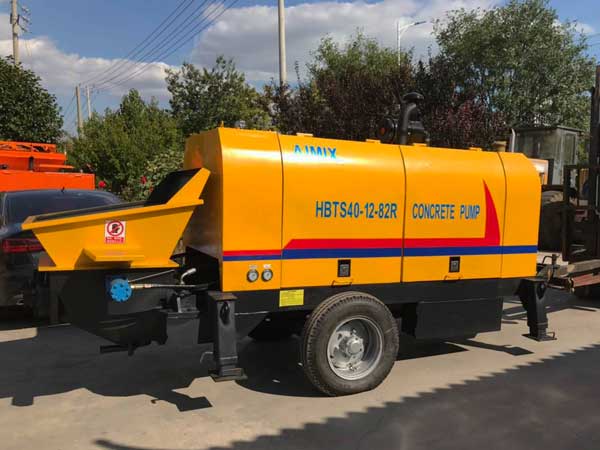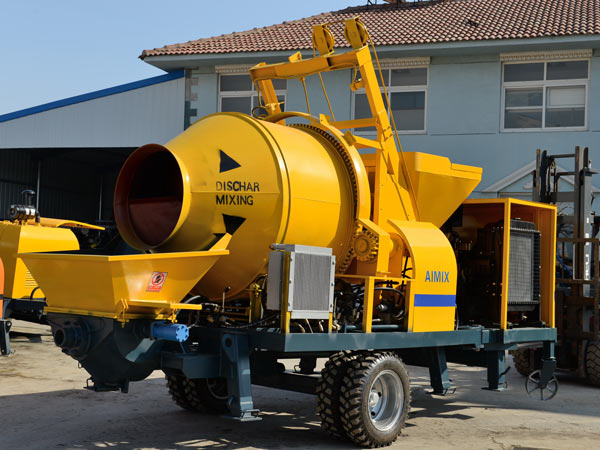Installing a concrete pump at a construction site is a critical task that requires meticulous planning, careful execution, and adherence to safety protocols. Concrete pumps are essential for efficiently transporting concrete from the mixing site to the placement site, especially in large-scale projects where traditional methods would be too slow or labor-intensive. Proper installation ensures that the concrete pump operates effectively and safely, reducing the risk of delays or accidents. Here’s a comprehensive guide on how to install a concrete pump at a construction site.

Pre-Installation Planning
Before the concrete pump arrives at the construction site, thorough planning is necessary to ensure a smooth installation process. Key steps in the pre-installation phase include:
Site Assessment: Conduct a detailed assessment of the construction site to determine the most suitable location for the concrete pump. The site should be level, stable, and easily accessible to the concrete delivery trucks. Ensure there is enough space for the pump to operate without obstructions.
Equipment Selection: Choose the right type of concrete pump based on the project’s requirements. There are different types of concrete pumps, including truck-mounted, trailer-mounted, and stationary pumps, each suited for specific types of projects. Consider factors like the distance the concrete needs to be pumped, the volume of concrete, and the layout of the construction site.
Permits and Regulations: Verify that all necessary permits and approvals have been obtained before installing the pump. This may include permits for equipment operation, noise, and environmental considerations. Ensure compliance with local regulations and safety standards.
Coordination with Stakeholders: Communicate with all stakeholders involved in the construction project, including the project manager, contractors, and the pump operator. Establish a clear timeline for the installation and ensure everyone is aware of their roles and responsibilities.
Delivery and Positioning of the Concrete Pump
Once the concrete pump arrives at the construction site, careful handling and positioning are crucial:
Receiving the Equipment: Inspect the concrete pump with mixer or without mixer upon delivery to ensure it is in good condition. Check for any visible damage during transport and verify that all necessary components and accessories are included.
Positioning the Pump: Position the concrete pump at the designated location on the site. The pump should be placed on a stable, level surface to prevent tipping or shifting during operation. For truck-mounted pumps, ensure the truck is parked on firm ground and that the outriggers are properly extended and locked into place for stability.
Access and Pathways: Ensure that there are clear pathways for the concrete delivery trucks to approach the pump and for the hoses or pipes to reach the pouring site. Avoid placing the pump too far from the pouring site, as this can lead to increased pressure requirements and potential blockages in the pipeline.
Setting Up the Pump System
Setting up the pump system involves connecting various components and preparing the pump for operation:
Connecting Hoses and Pipes: Attach the necessary hoses or pipes to the pump’s outlet. These will carry the concrete from the pump to the pouring site. Ensure that all connections are secure and properly sealed to prevent leaks or disconnections during pumping.
Securing the Pipes: Secure the pipes or hoses along their length to prevent movement or dislodging during operation. Use clamps, brackets, or supports as necessary, particularly at bends or junctions, to maintain stability.
Priming the Pump: Before starting the pump, prime the system to remove any air pockets and to lubricate the interior surfaces of the pipes. This is typically done by running a small amount of grout or water through the pump to coat the inside of the hoses and pipes, ensuring smooth concrete flow once pumping begins.
Checking Hydraulic and Electrical Systems: Inspect the hydraulic and electrical systems of the pump to ensure they are functioning correctly. Check fluid levels, power connections, and control panels for any signs of issues.

Safety Considerations
Safety is paramount during the installation and operation of a concrete pump. Some supplier like Aimix would provide safety protocols. Follow these safety protocols to minimize the risk of accidents:
Personal Protective Equipment (PPE): Ensure that all personnel involved in the installation wear appropriate PPE, including hard hats, gloves, safety glasses, and steel-toed boots.
Stabilization: Double-check the stabilization of the pump, especially if it is truck-mounted. The outriggers must be fully deployed and secure to prevent the vehicle from tipping.
Safe Working Distance: Maintain a safe distance between the pump and other construction activities. Concrete hoses can move unexpectedly during pumping, so ensure that workers are not positioned in vulnerable spots where they could be struck.
Emergency Procedures: Establish and communicate clear emergency procedures. Ensure that all workers know how to shut down the pump quickly in case of an emergency and that they are aware of the location of emergency stop buttons.
Testing the Pump
Before full-scale pumping begins, it’s essential to test the concrete pump to ensure that it is operating correctly:
Initial Test Pumping: Begin by pumping a small amount of concrete to test the system. Observe the flow rate, pressure, and consistency of the concrete as it moves through the hoses. Check for any leaks, blockages, or other issues that might affect the operation.
Adjusting Settings: Adjust the pump’s settings as needed based on the initial test. This might include changing the pump speed, pressure, or the positioning of the hoses to optimize performance.
Monitoring and Calibration: Continuously monitor the pump during the initial pumping phase. Ensure that all components are functioning properly and that the concrete is being delivered smoothly to the pouring site.
Full-Scale Operation
Once the pump has been successfully tested, it can be used for full-scale operation:
Continuous Monitoring: During operation, monitor the pump, hoses, and the flow of concrete closely. Be vigilant for any signs of issues such as blockages, pressure drops, or unusual noises that could indicate a problem.
Coordination with Pouring Team: Maintain clear communication with the team handling the concrete at the pouring site. Coordination is key to ensuring that the concrete is placed accurately and efficiently.
Adjusting as Needed: Be prepared to make adjustments to the pump or the positioning of hoses as the pouring progresses. Flexibility is often required, especially on large or complex construction sites.
Post-Operation Procedures
After the concrete pumping is complete, proper shutdown and cleanup procedures are essential:
Flushing the System: Flush the pump, hoses, and pipes with water or a suitable cleaning solution to remove any remaining concrete. This prevents the concrete from hardening inside the system and causing blockages.
Disassembling the Pump: Carefully disassemble the hoses and pipes, and clean each component thoroughly. Store all parts securely to prevent damage or loss.
Inspecting for Wear and Tear: After each use, inspect the pump and its components for signs of wear or damage. Replace any worn parts to ensure the pump is ready for future use.
Storing the Equipment: If the pump will not be used again immediately, store it in a secure, dry location to protect it from the elements and potential damage.
Installing a concrete pump at a construction site requires careful planning, precise execution, and a strong focus on safety. By following a systematic approach that includes pre-installation planning, proper equipment setup, rigorous safety protocols, and thorough post-operation procedures, you can ensure that the concrete pump operates efficiently and safely. Proper installation not only improves the quality of the concrete application but also helps prevent costly delays and accidents on the construction site. With attention to detail and adherence to best practices, you can achieve successful concrete pumping operations that contribute to the overall success of your construction project.